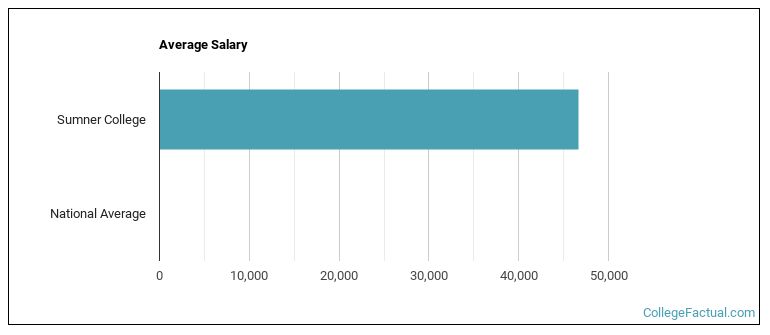 by our College Data Analytics Team
by our College Data Analytics TeamExplore the best ranked schools for the programs you are most interested in.
Sumner College was not ranked in College Factual's 2025 Best Overall Colleges report. This could be for a number of reasons, including lack of data.
Sumner College has an acceptance rate of 100%, so it is easier to gain admission to this school than some others. Still, the admissions staff will examine your application closely to make sure you're a good fit for Sumner College.
With a student to faculty ratio of 13 to 1, Sumner College is about average in this regard as the nationwide rate is 15 to 1. While this does not translate directly to class size, it's a good indicator of how much time professors will have to spend with their students on a one-on-one basis.
In addition to the student to faculty ratio, some people look at what percentage of faculty members are full-time as a sign of how much time professors will be able to spend with their students. This is because part-time teachers may not be be on campus as much as their full-time counterparts.
The full-time faculty percentage at Sumner College is 100%. This is higher than the national average of 47%.
During the 2017-2018 academic year, there were 464 full-time undergraduates at Sumner College.
| $0-30 K | $30K-48K | $48-75 | $75-110K | $110K + |
|---|---|---|---|---|
| $21,582 | $20,811 | $22,134 | $22,053 | $24,004 |
The net price is calculated by adding tuition, room, board and other costs and subtracting financial aid.Note that the net price is typically less than the published for a school. For more information on the sticker price of Sumner College, see our tuition and fees and room and board pages.
Almost 66% of college students who graduated with the class of 2018 took out student loans, but that percentage varies from school to school. At Sumner College, approximately 61% of students took out student loans averaging $7,028 a year. That adds up to $28,112 over four years for those students.

Get more details about the location of Sumner College.

Contact details for Sumner College are given below.
| Contact Details | |
|---|---|
| Address: | 8338 Ne Alderwood Road Ste 100, Portland, OR 97220 |
| Phone: | 503-972-6230 |
| Website: | sumnercollege.edu/ |
| Most Popular Majors | Bachelor’s Degrees | Average Salary of Graduates |
|---|---|---|
| Practical Nursing & Nursing Assistants | 176 | NA |
| Nursing | 102 | NA |
| Allied Health & Medical Assisting Services | 51 | NA |
Online learning options are becoming more and more popular at American colleges and universities. Online classes are great for students who have busy schedules or for those who just want to study on their own time.
In 2022-2023, 510 students took at least one online class at Sumner College. This is an increase from the 22 students who took online classes the previous year.
| Year | Took at Least One Online Class | Took All Classes Online |
|---|---|---|
| 2022-2023 | 510 | 26 |
| 2021-2022 | 22 | 22 |
| 2020-2021 | 8 | 8 |
| 2018-2019 | 0 | 0 |
Footnotes
*The racial-ethnic minorities count is calculated by taking the total number of students and subtracting white students, international students, and students whose race/ethnicity was unknown. This number is then divided by the total number of students at the school to obtain the racial-ethnic minorities percentage.
References
More about our data sources and methodologies.